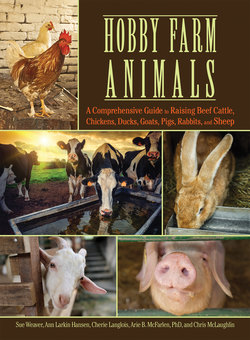Читать книгу Hobby Farm Animals - Chris McLaughlin - Страница 21
На сайте Литреса книга снята с продажи.
Record Keeping and Animal Identification
ОглавлениеKeeping a notebook to record vaccination, birth, weaning, breeding dates, and other important information for each animal in your herd helps keep your herd’s wellness and breeding programs on time and on track. After a few years of record keeping, you’ll be able to pick out which animals are healthiest, which breed back the quickest, and which raise the best calves. You’ll also be able to cull the cows that are most susceptible to health problems, are poor performers, or have bad dispositions. The result will, I hope, be a herd of uniform, docile, healthy cows that are a pleasure to own and for whose calves you will always have buyers.
Record keeping also plays a crucial role in US animal-health initiatives. Outbreaks of foot-and-mouth disease in Britain, anthrax and tuberculosis in the United States, and bovine spongiform encephalopathy (mad cow disease) in several countries fueled a federal government initiative to establish the National Animal Identification System (NAIS). The hope is that by identifying each animal individually and tracking the animal’s movements, any disease outbreak can be quickly traced to its origins and then suppressed. In my state, Wisconsin, all livestock owners are required to register their location and type of livestock with the state.
Many cattle owners already identify individual animals for their own records and breeding programs. The standard identification method for cattle is numbered ear tags. The tags and the tool for attaching them are available at farm supply stores. Get the large tags; the hairy ears of cattle make it hard to read the small ones. You can buy tags that are already numbered, or you can get a special marker and blank tags and do the numbering yourself. Attach the tag in the center of the ear when you’ve got the animal in the headgate for vaccination. Tags too close to the edge have a tendency to rip out. Make sure that the tag is on the front side of the ear and that the number is facing forward.
| ADVICE FROM THE FARM To Their Health How do you spot a sick animal? With my cattle, it’s really easy—if I take feed out and one is slow coming up, I know something’s up. The best way is to check on them every day. I have it a little easier because they’re close (to the house). If I walk out to the barn, they’re talking to me. I keep a real close eye on them. The meek one, for example, will walk up to me, and I’ll pat it on the forehead and I know it’s feeling fine. If it doesn’t do that, I know something’s up. —Randy Janke When action is needed, your response may range from catching the animal for closer examination and treatment to calling the vet. When to call the vet is a matter of your comfort level, knowledge, and experience. This is where a knowledgeable and experienced neighbor can be very helpful. Such a neighbor can demonstrate the way to take a temperature, or inspect feet, or take one look and say, “Call the vet.” If there is ever a question in your mind about whether to call or not to call, call! It’s better to overreact than to lose an animal. —Sherri Schulz, DVM |
